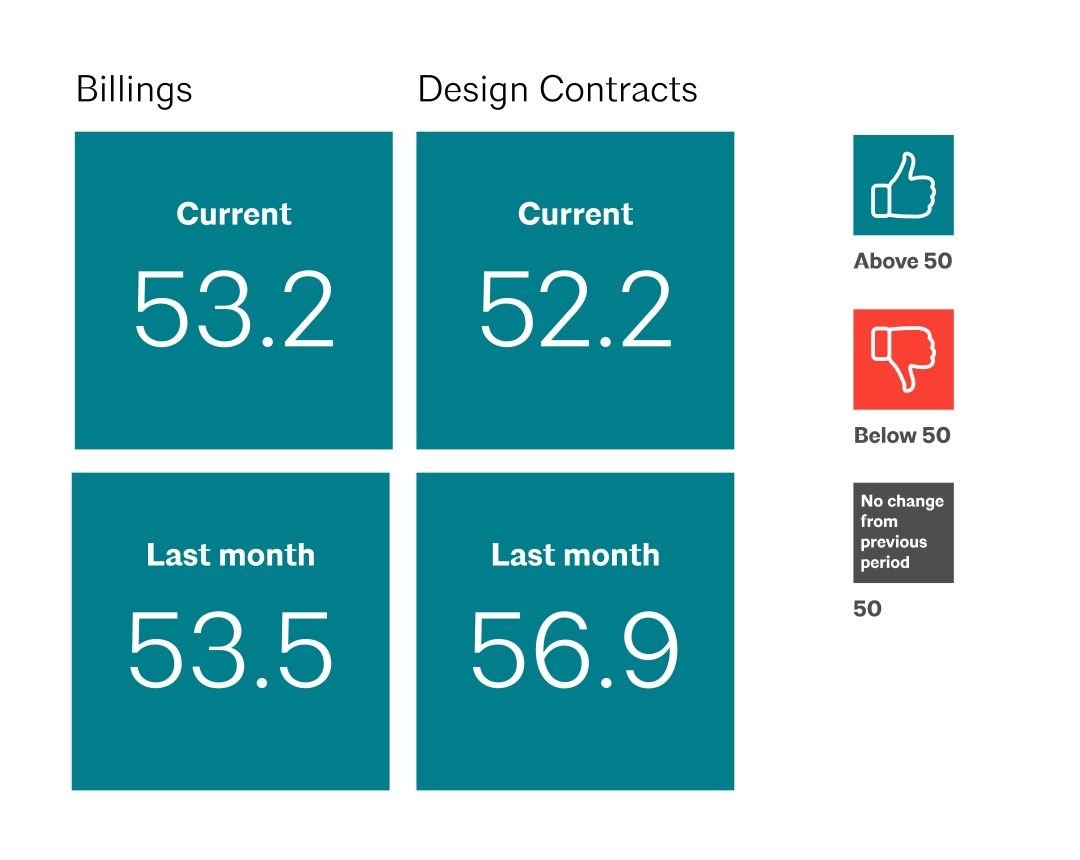ABI June 2022: Architecture firms continue to report modest billings growth

More than two thirds of firms report employing staff that engage in sustainability objectives for design projects
Architecture firm billings continued to grow at a modest pace in June. After a burst of stronger growth in the spring, the pace has returned to more modest territory over the last two months, with a score of 53.2 for June (any score over 50 indicates billings growth). However, still-rising inflation, as well as higher interest rates and a continued shortage of certain building and construction materials, means that the future is looking increasingly cloudy. While inquiries into new projects continued to grow at a steady pace this month, it was the slowest rate of growth since the recovery began in early 2021. In addition, the value of new signed design contracts also fell to the slowest pace of growth since January 2021. And backlogs at firms, which had been growing at a torrid pace recently, declined slightly, from an average of 7.2 months at the end of the first quarter of 2022, to an average of 7.0 months at the end of the second quarter. However, these are still extremely strong backlogs, meaning that most firms still have a robust supply of work in the pipeline.
Business conditions remained mixed in different areas of the country this month, as they have for much of the year so far. Following two months of modest growth, firm billings declined slightly at firms located in the Northeast in June. And the pace of growth at firms in the South slowed further, after seeing the strongest growth earlier this year. Business conditions were strongest at firms located in the West for the third month in a row, and were also strong at firms located in the Midwest. By firm specialization, firms with an institutional specialization reported the strongest growth for the first time since before the pandemic. The majority of firms with multifamily residential and commercial/industrial specializations also saw an increase in their billings, but the pace of that growth continued to slow at both.
Inflation continues to rise, impacting interest rates
Inflation remained a key concern in the broader economy in June, with the Consumer Price Index (CPI) increasing by 1.3% from May, for an increase of a whopping 9.1% from one year ago. In addition, core inflation, which had projected to start moderating, increased by an additional 0.7%, for an increase of 5.9% from June 2021. With inflation continuing to rise, it looks likely that the Federal Reserve will hoist another substantial increase in interest rates at their meeting in late July, with predictions estimating that they will increase by 0.75%-1%.
In more positive news, employment has continued its post-pandemic rebound, with nonfarm payroll employment adding an additional 372,000 jobs in June. While it is now just 0.3% below its pre-pandemic peak, private sector employment has already fully recovered, and is now 140,000 jobs higher than it was in February 2020. However, architecture employment declined again in May (the most recent data available), shedding 1,600 jobs, for a total loss of 1,900 jobs since its most recent peak of 200,000 total employees in March. Unfortunately, this, coupled with slowing inquiries and design contracts, may be an early sign of caution on the horizon.
Large firms more likely to have staff engaging with sustainability objectives
Following up on last month’s questions about sustainability in project design, this month we asked firms about staff work on sustainability objectives. On average, slightly more than two thirds of responding firms (67%) indicated that they have staff at their firm that engage in sustainability objectives for design projects. This share was highest at firms with an institutional specialization (73%), versus just 54% of firms with a commercial/industrial specialization reporting that their staff engage in sustainability objectives. Large firms were the most likely to report this, however, with 85% of firms with annual billings over $5 million indicating that their staff engage with sustainability objectives.
However, few firms reported that they have a dedicated professional staff working on sustainability objectives for design projects – just 8%, while 82% indicated that it is more integrated, with all teams work on sustainability objectives for design projects (the remaining 10% had an “other” response). Large firms with annual billings of $5 million or more and those located in the Midwest were slightly more likely to report having a dedicated sustainability staff, at 15% and 14%, respectively. And of the firms that indicated having a dedicated professional staff working on sustainability objectives for design projects, the key responsibilities of that staff were identified as design (65%), model development/tools (55%), senior management/strategy (50%), and consulting (50%).
This month, Work-on-the-Boards participants are saying:
- “Business conditions in our area are strong. At this time, we are able to replenish our backlog each month that totals or exceeds the prior month’s billings.”— 26-person firm in the South, commercial/industrial specialization
- “Owners and developers are starting to put projects on hold. With the high labor costs, rising inflation, and higher interest rates, projects that we were confident in moving forward have been put to a halt.”—6-person firm in the Midwest, residential specialization
- “Still busy and hard to find more help, so we have gone to a third party to keep up with demand.”—40-person firm in the West, commercial/industrial specialization
- “Inquiries continue to come in, but closing them has been challenging due to client caution. Clients are watching their own income more closely.”—6-person firm in the Northeast, institutional specialization

Responses